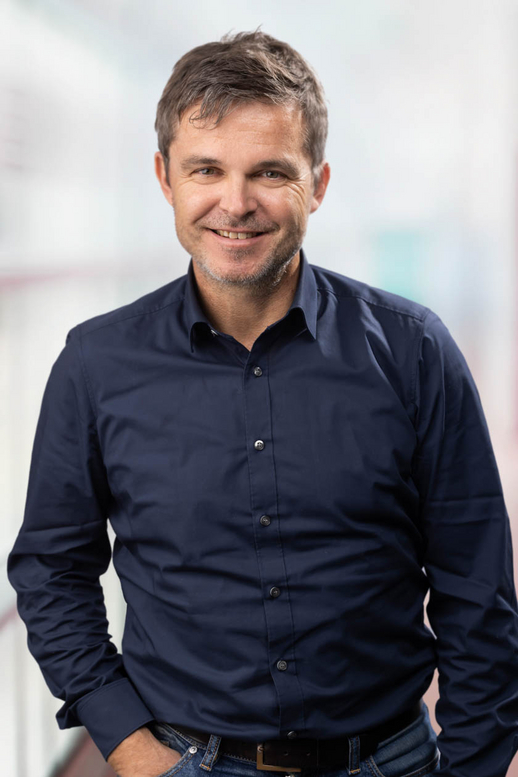Prof. Dr. Alexander Rohrbach

Contact
University of Freiburg
T +49 761 203 7536
rohrbach(at)imtek.de
Further Information
Living cells are fascinating microsystems driven by a variety of physics principles. For instance, it is well known thatnearly every transport and interaction process in living cells is governed by thermal noise. However, it is hardly known or often disregarded that while interactions can be visible on one timescale, they can be completely invisible on another. Therefore, it is not only necessary to measure on a broad frequency range, but also to decompose the broadband fluctuation data with appropriate models. Therefore, we develop fast optical measurement technology and biophysical computer simulations to understand biological interactions on time scales from minutes to micro-seconds – at or beyond the limits of diffraction, of photon noise and of diffusion.
We advance novel super-resolving laser optical microscopy with and without labels and we advance optical tweezers-based applications such as Photonic Force Microscopy, with MHz interferometric tracking. With this we investigate the biophysics of living immune cells, of bacteria and of bio-mimetic systems, where we record and analyze the nano-mechanics and thermal fluctuations of cellular structures and their interaction partners. These approaches will help us to better understand e.g. infection diseases.
Keywords
Molecular interaction, Across time scales, Broad bandwidth measurements, Super-resolution microscopy, Optical tweezers, 3D particle tracking, Computer simulations, Particle binding to cells, Phagocytosis, Bacterial cytoskeleton and cell wall
“Thermal noise drives cellular structures and particles on nanometer and microsecond scales. This motion regulates the life of each cell and organism. If we want to understand this motion, we have to measure it.”
10 selected publications:
- Thermal fluctuations of the lipid membrane determine particle uptake into Giant Unilamellar Vesicles.
Ayala YA, Omidvar R, Römer W, Rohrbach A.
Nat Commun. 2023 Jan 4;14(1):65 - 100 Hz ROCS microscopy correlated with fluorescence reveals cellular dynamics on different spatiotemporal scales.
Jünger F, Ruh D, Strobel D, Michiels R, Huber D, Brandel A, Madl J, Gavrilov A, Mihlan M, Daller CC, Rog-Zielinska EA, Römer W, Lämmermann T, Rohrbach A.
Nat Commun. 2022 Apr 1;13(1):1758. - Towards non-blind optical tweezing by finding 3D refractive index changes through off-focus interferometric tracking.
Landenberger B, Yatish, Rohrbach A.
Nat Commun. 2021 Nov 26;12(1):6922. - Surface imaging beyond the diffraction limit with optically trapped spheres.
Friedrich L, Rohrbach A (2015).
Nat Nanotechnol. 10(12):1064-9. - Superresolution Imaging of Dynamic MreB Filaments in B. subtilis - A Multiple-Motor-Driven Transport?
v Olshausen P, Soufo HJD, Graumann P, Wicker K, Heintzmann R, Rohrbach A (2013).
Biophys J. 105(5):1171 – 1181 - Object adapted optical trapping and shape tracking of energy switching helical bacteria.
Koch M. Rohrbach A (2012).
Nat Photonics, 6, 680 - 686 - Propagation stability of self-reconstructing Bessel beams enables contrast-enhanced imaging in thick media.
Fahrbach FO, Rohrbach A (2012)
Nature Communications 3: p. 632. - Microscopy with self-reconstructing beams.
Fahrbach, FOP, Simon P, Rohrbach A (2010).
Nature Photonics. 4(11):780-785 - Filopodia act as phagocytic tentacles and pull with discrete steps and a load-dependent velocity.
Kress H, Stelzer EHK, Holzer D, Buss F, Griffiths G, Rohrbach A (2007).
Proc Nat Acad Sci.104, 11633–11638 - Stiffness of optical traps: quantitative agreement between experiment and electromagnetic theory.
Rohrbach A.
Phys Rev Lett. 2005 Oct 14;95(16):168102.



